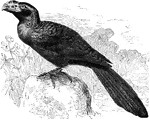
Smooth-billed Ani
"Crotophaga ani. Smooth-billed Ani. Black Witch. Savanna Blackbird. Bill smooth or with a few transverse;…
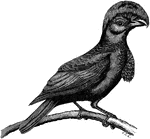
Amazonian Umbrella Bird
"Cephalopterus ornatus, the Umbrella bird, is entirely black, with a huge expanded umbrella-like crest…

Red-winged Blackbird
"Agelaeus phoeniceus. Blackbird. marsh Blackbird. Red-winged Blackbird. Red-and-buff-shouldered marsh…

Yellow-headed Blackbird
"Xanthocephalus icterocephalus. Yellow-headed Blackbird. Male: Black, including lores and small space…

Eastern Blue-Bird
"in full plumage: Rich azure-blue, the ends of the wing-quills blackish; throat, breast, and sides of…
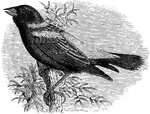
Bobolink
"Dolichonyx oryzivorus. Bobolink. Meadow-wink. Skunk Blackbird (Northern States), Reed-bird (Middle…
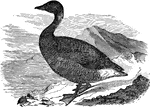
Common Brant
"Bernicla brenta. Brant Goose. Bill, feet, and claws black; iris brown. Head and neck all around, and…
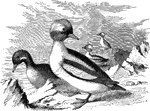
Buffleheads
"Clangula albeola. Buffle-head. Butter-ball. spirit-duck. Dipper. Bill with nostrils rather behind than…
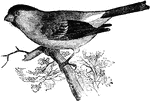
Cassin's Bullfinch
"Pyrrhula cassini. Cassin's Bullfinch. Above, clear ashy-gray; below, cinnamon-gray; rump and under…
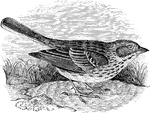
Bay-winged Bunting
"Pooecetes gramineus. Grass Finch. Bay-winged Bunting. Vesper-bird. Above, grayish-brown, closely and…
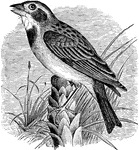
Black-throated Bunting
"Spiza americana. Black Throated Bunting. Above, grayish-brown, the middle of the back streaked with…

Lark Bunting
"Calamospiza bicolor. Lark Bunting. White-winged Blackbird. Black, with A large white patch on the wings;…
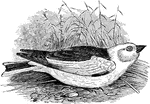
Snow Bunting
"Plectrophanes nivalis. Snow Bunting. Snowflake. Pure white; the bill, feet, middle of back, scapulars,…
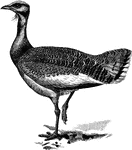
Great Bustard
"The Otis Tarda, the Great Bustard, which, as a native only became extinct in Norfolk about 1838, used…

Butcher-bird
"Lanius borealis. Great Northern Shrike. Butcher-bird. Great Grey Shrike. Above, clear bluish-ash, blanching…

Butcher-bird Head
"Lanius borealis. Great Northern Shrike. Butcher-bird. Great Grey Shrike. Above, clear bluish-ash, blanching…
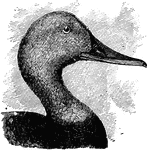
Canvas-back Head
"Fuligula vallisneria. Canvas-back. Adult male: The head close-feathered. Bill high at the base and…
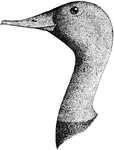
Large Canvas-backs Head
"Fuligula vallisneria. Canvas-back. Adult male: The head close-feathered. Bill high at the base and…
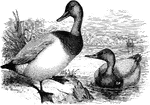
Canvas-backs
"Fuligula vallisneria. Canvas-back. Adult male: The head close-feathered. Bill high at the base and…
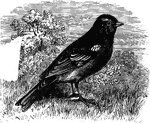
Chaffinch
Fringilla coelebs. Chaffinch. A small finch with edges of the tail being white, white bars on wings,…

Black-capped Chickadee
"Crown and nape, with chin and throat, black, separated by white sides of the head. Upper parts brownish-ash,…

Mountain Chickadee
"Upper part ashy-gray, with scarcely a shade, and only on the rump, under parts similarly grayish-white,…

Coot Head
"Fulicia. Coot. Bill and frontal plate much as in the Gallinultes. Body depressed; the under plumage…

Black and White Creeper
"Black and White Creeper or Mniotilta varia. Black; edges of feathers of upper parts, coronal, superciliary,…
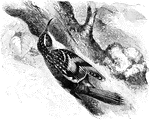
Common Brown Creeper
"Common Brown Creeper. Upper parts dark brown, changing to rusty-brown on the rump, everywhere streaked…

Blue Crow
"Gymnocitta cyanocephala. Blue Crow. Male: Dull blue, very variable in intensity, nearly uniform, but…
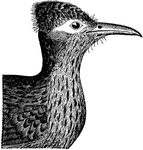
Ground Cuckoo Head
"Geococcyx californianus. Ground Cuckoo. Chaparral Cock. Road Runner. Snake Killer. Paisano. Most of…
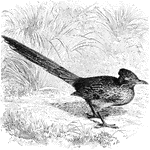
Ground Cuckoo
"Geococcyx californianus. Ground Cuckoo. Chaparral Cock. Road Runner. Snake Killer. Paisano. Most of…

Small Yellow-billed Cuckoo
"Coccygus americanus. Yellow-billed Cuckoo. Bill black, extensively yellow below and on the sides of…
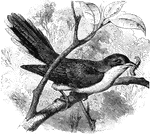
Yellow-billed Cuckoo
"Coccygus americanus. Yellow-billed Cuckoo. Bill black, extensively yellow below and on the sides of…
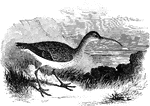
Hudsonian Curlew
"Numenius hudsonicus. Hudsonian Curlew Jack Curlew. General tone of coloration scarcely rufous, the…

Carolina Dove
"Zenaidura carolinensis. Carolina Dove. Mourning Dove. Wild Dove. Upper parts, including middle tail-feathers,…

Pin-tail Duck Head
"Dafila. Pin-tail Ducks. Tail (in adult male) narrow, cuneate, when fully developed nearly as long as…
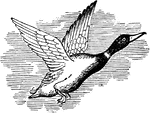
Wild Duck
"Anus boscas. Mallard. Wild or Domestic Duck. Green-head. Bill greenish-yellow. Feet orange-red. Iris…
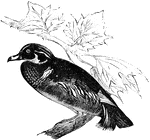
Wood Duck
"Aix sponsa. Wood Duck. Summer Duck. "The Bride." Adult Male: Bill pinkish-white, with lake-red base,…
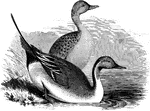
Pin-tail Ducks
"Dafila acuta. Pin-tail Duck. Sprig-tail. Bill black, with grayish-blue edge of upper mandible; feet…
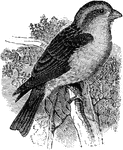
Purple Finch
"Carpodacus purpureus. Purple Finch (better Crimson Finch). Rose-red, paler below, insensibly whitening…
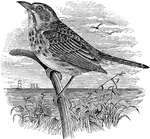
Seaside Finch
"Ammodramus maritimus. Seaside Finch. Olive-gray, obscurely streaked on back and crown with darker and…

Swainson's Rosy Finch
"Leucosticte tephrocotis. Swainson's Rosy Finch. Gray-crowned Rosy Finch. Sexes similar. Adult in breeding…
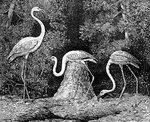
American Flamingo
"Phoinikopteros ruber. American Red Flamingo. Adult: Plumage scarlet, the primaries and most of the…
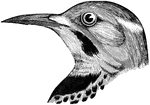
Flicker
"Colaptes auratus. Golden-winged Woodpecker. Pigeon Woodpecker. Flicker. Yucker. High-holder. Back and…
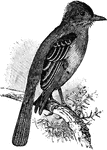
Great Crested Flycatcher
"Myiarchus crinitus. Great Crested Flycatcher. Decidedly olivaceous above, a little browner on head,…

Meadow Lark Foot and Bill
"Sturnella magna. Field Lark. Old-field Lark. Meadow Lark. The colors, as above described, rich and…
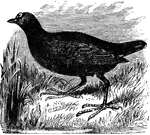
Gallinule
"Gallinula. Gallinules. Water Hens. Mud Hens. Bill not longer than head, stout at base, tapering, compressed,…
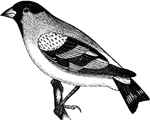
Lawrence's Goldfinch
"Astragalinus lawrencii. Lawrence's Goldfinch. Gray, more or less tinged with yellowish, whitening on…

Arkansaw Goldfinch
"Astragalinus psaltria. Arkansaw Goldfinch. Upper parts uniform olive-green, without any black; below…
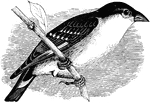
Mexican Goldfinch
"Astragalinus mexicanus. Mexican Goldfinch. The upper parts continuously-black, and the black of the…
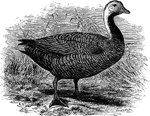
Emperor Goose
"Philacte canagica. Painted Goose. Emperor Goose. Wavy bluish-gray, with lavender or lilac tinting,…

Purple Grackle
"Quiscalus purpureus. Purple Crow Blackbird. Common Crow Blackbird. Purple Grackle. Of medium size,…
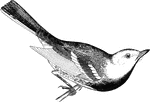
Black Throated Green Warbler
"Black Throated Green Warbler or Dendroica virens. Back and crown clear yellow-olive; forehead, superciliary…

Black-headed Song Grosbeak
"Zamelodia melanocephala. Black-headed Song Grosbeak. Adult male with the crown, sides of head, back,…
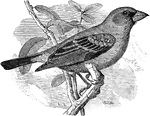
Blue Grosbeak
"Guiraca caerulea. Blue Grosbeak. Adult male: Rich dark blue, nearly uniform, but darker or blackish…
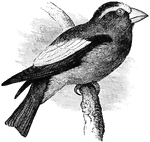
Evening Grosbeak
"Hesperophona vespertina. Evening Grosbeak. General color sordid yellow, overlaid with sooty-olive shade,…
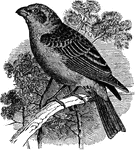
Pine Grosbeak
"Pinicola enucleator. Pine Grosbeak. Light carmine or rosy-red, feathers of back with dusky centres;…
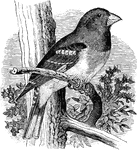
Rose-breasted Song Grosbeak
"Zamelodia ludoviciana. Rose-breasted Song Grosbeak. Adult male with the head and neck all around and…

Ruffed Grouse Head
"Bonasa umbella. Ruffed Grouse. "Partridge;" "Pheasant;" Above, variegate reddish- or grayish-brown,…

Canada Grouse
"Canace canadensis. Canada Grouse. Spotted Grouse. Spruce Grouse. Spruce "Partridge." Adult: Head smooth,…
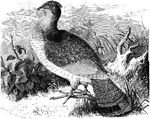
Ruffed Grouse
"Bonasa umbella. Ruffed Grouse. "Partridge;" "Pheasant;" Above, variegate reddish- or grayish-brown,…
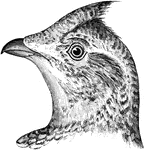
Sharp-tailed Grouse
"Pediaecetes phasianellus Columbianus. Common Sharp-tailed Grouse. Upper parts closely and pretty evenly…
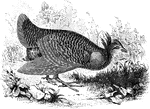
Prairie Hen
"Cupidonia cupido. Pinnated Grouse. Prairie Hen. Above, variegated with black, brown, tawny, or ochrey,…